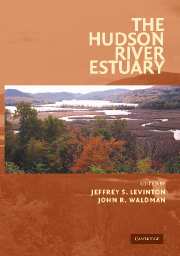Book contents
- Frontmatter
- Contents
- Preface
- List of Contributors
- The Hudson River Estuary
- 1 The Hudson River Estuary: Executive Summary
- GEOLOGICAL, PHYSICAL, AND CHEMICAL SETTING OF THE HUDSON
- PRIMARY PRODUCTION, MICROBIAL DYNAMICS, AND NUTRIENT DYNAMICS OF THE HUDSON
- HUDSON RIVER COMMUNITIES, FOOD WEBS, AND FISHERIES
- CONTAMINANTS AND MANAGEMENT ISSUES OF THE HUDSON RIVER ESTUARY
- 22 The History and Science of Managing the Hudson River
- 23 Hudson River Sewage Inputs and Impacts: Past and Present
- 24 PCBs in the Upper and Tidal Freshwater Hudson River Estuary: The Science behind the Dredging Controversy
- 25 Transport, Fate, and Bioaccumulation of PCBs in the Lower Hudson River
- 26 Contaminant Chronologies from Hudson River Sedimentary Records
- 27 Atmospheric Deposition of PCBs and PAHs to the New York/New Jersey Harbor Estuary
- 28 Toxic Substances and Their Impact on Human Health in the Hudson River Watershed
- 29 Impacts of Piers on Juvenile Fishes in the Lower Hudson River
- 30 Physiological and Genetic Aspects of Toxicity in Hudson River Species
- Index
- Plate section
- References
25 - Transport, Fate, and Bioaccumulation of PCBs in the Lower Hudson River
Published online by Cambridge University Press: 06 January 2010
- Frontmatter
- Contents
- Preface
- List of Contributors
- The Hudson River Estuary
- 1 The Hudson River Estuary: Executive Summary
- GEOLOGICAL, PHYSICAL, AND CHEMICAL SETTING OF THE HUDSON
- PRIMARY PRODUCTION, MICROBIAL DYNAMICS, AND NUTRIENT DYNAMICS OF THE HUDSON
- HUDSON RIVER COMMUNITIES, FOOD WEBS, AND FISHERIES
- CONTAMINANTS AND MANAGEMENT ISSUES OF THE HUDSON RIVER ESTUARY
- 22 The History and Science of Managing the Hudson River
- 23 Hudson River Sewage Inputs and Impacts: Past and Present
- 24 PCBs in the Upper and Tidal Freshwater Hudson River Estuary: The Science behind the Dredging Controversy
- 25 Transport, Fate, and Bioaccumulation of PCBs in the Lower Hudson River
- 26 Contaminant Chronologies from Hudson River Sedimentary Records
- 27 Atmospheric Deposition of PCBs and PAHs to the New York/New Jersey Harbor Estuary
- 28 Toxic Substances and Their Impact on Human Health in the Hudson River Watershed
- 29 Impacts of Piers on Juvenile Fishes in the Lower Hudson River
- 30 Physiological and Genetic Aspects of Toxicity in Hudson River Species
- Index
- Plate section
- References
Summary
abstract A mass balance model was developed to examine the transport, fate, and bioaccumulation of Polychlorinated Biphenyls (PCBs) in the Lower Hudson River. The model was applied to five (di- through hexa-) PCB homologues over a fifteen-year simulation period (1987–2002) and results compared well to observed PCB homologue concentrations in river sediments and fish. From model evaluations, we found that partitioning of PCBs to suspended solids appears to be largely controlled by phytoplankton. Phytoplankton production and subsequent decomposition of phytoplankton-derived material in sediments plays a particularly important role in scavenging PCBs from the water column and accumulating them in sediments. In addition, there is a continuous exchange of PCBs between the overlying water and surface sediments associated with settling of phytoplankton and other suspended organic matter, resuspension of sedimentary organic matter, and pore water diffusion of dissolved and dissolved organic carbon (DOC)-bound contaminant. These processes, along with the large capacity of sediments to store contaminants, work to sequester PCBs in sediments during periods of high contaminant loads and subsequently release them to the overlying water. This results in highly dampened responses of PCBs in water, sediments and fish in the mid estuary, and in “smearing” the effects of increased PCB loads from the Upper Hudson in the early 1990s. Model results clearly demonstrate that both the magnitude and distribution of PCBs in sediments and fish are strongly dependent on homologue-specific partitioning behavior (as expressed in terms of hydrophobicity and Kow values). Finally, the migration of striped bass also plays a critical role in limiting their exposure to PCBs in the mid estuary.
- Type
- Chapter
- Information
- The Hudson River Estuary , pp. 368 - 382Publisher: Cambridge University PressPrint publication year: 2006
References
- 2
- Cited by



